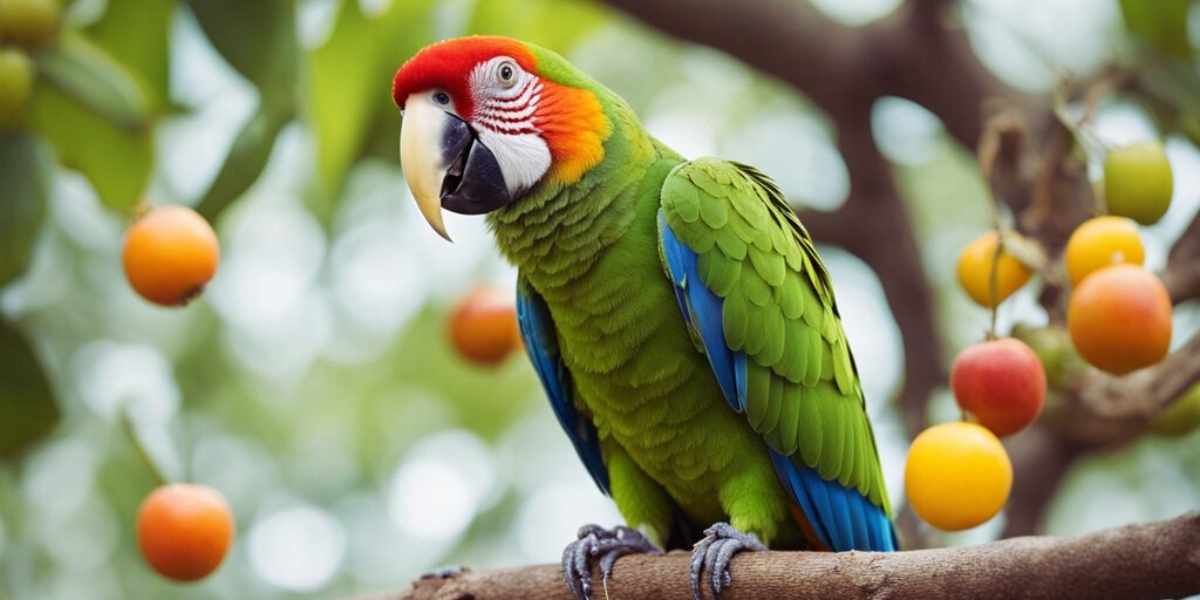Parrots are highly intelligent birds that have evolved specialized skills and behaviors to help them locate food sources. Their distinctive curved beaks and zygodactyl feet (two toes facing forward, two facing back) are perfectly adapted for gripping, cracking open, and extracting seeds and nuts. But finding sufficient nourishment in the wild requires more than physical attributes. Parrots rely heavily on their senses of sight and smell and exhibit complex foraging strategies to seek out fruits, seeds, nuts, nectar, insects, and other dietary components. Even pet parrots utilize some of these innate food-finding abilities.
How Parrots Locate Food Sources?
Parrots have developed a number of physical and behavioral adaptations to efficiently find food in their environments.
Vision
Vision is a parrot’s primary sense for locating food at a distance. As prey animals, their eyes are located on the sides of their heads, giving them a wide field of view to spot food sources and potential threats. Many parrots have excellent color vision and visual acuity that allows them to identify ripe fruits and seeds from afar.
Some parrots, like macaws, have specially adapted color vision and UV sensitivity that aids their foraging. They can perceive colors and patterns on fruits and flowers that are invisible to humans and many other animals. This helps macaws efficiently find mature fruits and nutritious nectar sources.
Smell
Parrots have a surprisingly good sense of smell, which they utilize to locate food sources nearby. Their large olfactory bulbs and nostrils can detect subtle odors emitted from fruits, blossoms, and herbs. Some parrots like kakapos and vultures even use scent to locate carrion sources of meat and fat.
Smell allows parrots to assess food quality and ripeness at close range. It may also help parrots find distant food locations by smelling them from the air while in flight.
Foraging Behaviors
Parrots exhibit a range of foraging strategies and food-seeking behaviors:
- Flock feeding – Many parrot species travel and feed in large flocks or colonies, maximizing their ability to find dispersed food sources. Information about food locations is shared socially within the flock.
- Coordinated feeding – Some parrots show cooperative feeding behaviors, with different birds taking on specific roles to maximize foraging. For example, monk parakeets stand guard to alert a feeding flock of approaching danger.
- Exploratory feeding – Parrots are very tactile, using their beaks and tongues to probe and taste-test potential foods. This helps them determine if an unknown item is edible.
- Tool use – Some parrots use simple tools to access seeds or fruits that are hard to reach, such as thorny acacia pods that keas pry open with sticks.
What Parrots Eat in the Wild?
Parrots have adapted to specialized diets depending on the native foods found in their habitat. But they primarily forage for three things:
Seeds, Nuts, and Fruits
The vast majority of wild parrots are granivores, feeding mainly on the seeds of grasses, herbs, shrubs, and trees. Others supplement this diet with nuts, berries, and fruits. The large curved beak of parrots allows them to crack hard shells and extract the nutritious contents.
Many parrots have dietary preferences for certain seeds and nuts. For example, the Carolina parakeet favored cockleburs, while the thick-billed parrot specialized on pine nuts. But most parrots are opportunistic foragers, taking advantage of seasonally available foods.
Insects
While not the main component of their diet, many parrots supplement their seed and plant diet with protein-rich insects and insect larvae. Some species like grass parakeets regularly feed on ants, termites, beetles, and other insects to meet their nutritional needs.
Flower Nectar
Some parrots have evolved the ability to drink nectar from flowers. Lories and lorikeets like the rainbow lorikeet have specialized brushy tongues to slurp up flower nectar. Others like the kakapo have lost the ability to fly, but can climb trees to access this energy-rich food source.
How Pet Parrots Find Their Food?
As domesticated animals, pet parrots now rely on their owners to provide their daily food and water. But some components of their wild food-finding abilities remain:
Relying on Owners
Pet parrots associate their owners with safety and sustenance. Through operant conditioning, they recognize cues like scheduled feeding times, food containers, and owner behaviors that signal the availability of food.
Some pets exhibit begging vocalizations and movements that manipulate owners into providing food rewards. This demonstrates their social intelligence and ability to communicate their needs.
Foraging Toys and Puzzles
Owners can engage a pet parrot’s natural foraging instincts by offering specially designed food puzzles, hidden treats, and foraging toys that mimic the challenge of finding food in the wild. These provide mental stimulation and enrichment for captive parrots.
Food-related play is also important for young hand-fed parrots to develop proper beak and foot coordination and motor skills.
Challenges for Parrots Finding Food!
While parrots are well adapted for locating food, they face increasing challenges in the wild due to human impacts:
Habitat Loss
Deforestation and loss of native habitat deprives parrots of traditional food sources and nesting sites. As forests are cleared, competition over remaining resources increases.
Competition with Invasive Species
Invasive bird species introduced by humans, like sparrows and starlings, compete with native parrots for food and nesting cavities. Some even directly prey on eggs and hatchlings.
Climate Change
Rising temperatures and altered precipitation patterns affect the seasonal availability of nuts, fruits, and nectar sources that parrots depend on. Their migration and reproduction may become mismatched with the food supply.
People Also Read:
Conclusion
Through keen senses adapted specifically for food location, innate foraging behaviors, and flexible omnivorous diets, parrots are able to locate and consume diverse food sources ranging from seeds and nuts to fruits, nectar, and even insects. However, habitat loss, competition from invasive species, and climate change pose serious challenges for wild parrots to find sufficient nutrition. Responsible conservation practices can help protect essential foraging habitats and food sources to ensure the future survival of these highly intelligent and resourceful birds.
FAQs
What do parrots like to eat?
Parrots are omnivorous, but prefer to eat seeds, nuts, grains, fruits, berries, and vegetation. Some supplement their diet with nectar and insects. Different parrot species have specialized food preferences.
How do parrots find food?
Parrots use their powerful vision to find food from a distance. Up close, they use their sense of smell to assess ripeness and locate food. They exhibit specialized foraging behaviors like flock feeding and coordinated feeding strategies.
Do parrots remember where food is located?
Yes, parrots have impressive spatial memory and recall. They are able to remember locations of feeding sites, water sources, and even small cached food stores for future recovery. Their brains contain a specialized region called the nidopallium that is dedicated to spatial mapping.
Can pet parrots find their own food?
Domesticated parrots rely on owners to provide their daily diet. But they can utilize foraging toys and puzzles that allow them to work for food rewards, stimulating their natural abilities and instincts to seek out nourishment.
Why is it hard for some wild parrots to get enough food?
Habitat destruction, competition from invasive species, and climate change all threaten wild parrot’s food supplies. Loss of forests and native vegetation removes food sources and nesting sites. Competition over remaining resources increases, while changes in seasonal food availability can create food scarcity.

